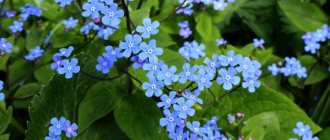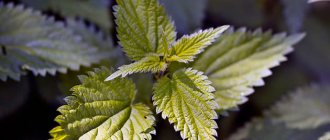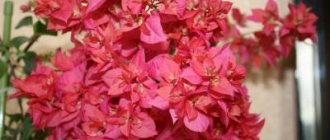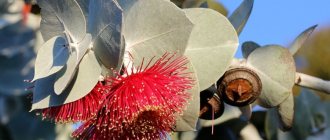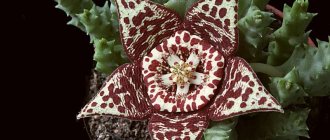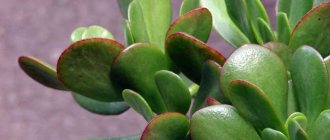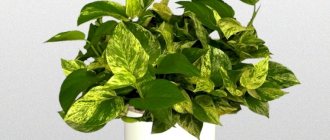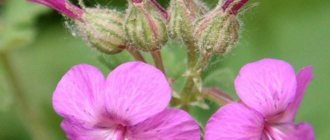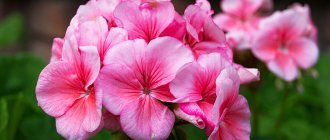There are contraindications, consultation with a specialist is required
Pelargonium or fragrant geranium - for many people, this is a favorite flower that has successfully taken root on their home windowsills. This perennial plant is almost unpretentious, does not require special attention, but delights with its bright colors and delicate aromas that this wonderful flower exudes. Fragrant geranium is a generally recognized plant in many countries on our planet; it has a large number of varieties and names. For example, in Bulgaria it is called “Health Resort”, in England “Crane Tree”, in Germany “Stork Tail”, but geranium received its most affectionate name in Russia, where it is affectionately and lovingly called “Crane Tree”. This beautiful plant not only has a wide palette of bright colors in its flowers, but also, depending on the variety, exudes different aromas. Geranium can delight with a variety of scents - orange, ginger, cinnamon, lemon, mint, nutmeg, rose, apple.
In this article, we will talk about fragrant geranium, which has medicinal properties and a healing aroma. Thanks to a large number of essential oils, fragrant geranium not only fills the room with a pleasant smell, but also cleanses the air of pathogens. In addition, leaves of fragrant geranium, placed in a closet, will protect and eliminate the appearance of moths and their larvae.
This miraculous plant has found its wide application in folk medicine and is used in different countries of the world. Almost all parts of fragrant geranium have healing properties, but in most cases, only the leaves are used, from which decoctions, compresses, lotions, and aromatic oils are made. If you do not have this wonderful plant at home, then you can purchase both dry raw materials and aromatic oil of fragrant geranium in free access in pharmacy chains.
What does geranium look like?
The botanical name of geranium is pelargonium domestica. It grows as a small shrub with erect stems that can be drooping. The foliage is round or rugged, covered with small fibers. The color is green, and there are also varieties with variegated foliage. The flowers are smooth or velvety, collected in inflorescences. Most often it blooms in red, but there are white, pink and other colors. The plant has a specific rich aroma. There are 250 of its varieties: some of them can be planted in open ground or in hanging pots.
Description of the plant
Fragrant pelargonium is a perennial subshrub. At home, it can stretch into a long vine and, if not timely pruned, fill the entire window. With good lighting and a sufficient amount of nutrients, geranium stretches up to 2 meters, forming a spreading bush. The lower part of the trunk often becomes woody. The entire plant is covered with glandular hairs, upon contact with which a strong odor is emitted. The arrangement of leaves is alternate; on long petioles there are very decorative palmate-lobed leaves. They cover the entire bush with thick, lacy greenery. Depending on the variety, the leaf blade can be deeply dissected, “curly” or silver, with an openwork or wavy edge. The root system is fibrous. The flowering is inconspicuous, small pink or purple flowers are collected in a loose umbrella inflorescence. The two upper petals are bent upward, the three lower ones are directed clearly downward. At home, flowering may not occur.
Chemical composition of geranium
The benefits of geranium depend on a set of chemical elements that provide the flower with healing properties.
The plant contains:
- tanning agents;
- useful acids;
- esters;
- flavonoids;
- pectin;
- carotene;
- ascorbic acid;
- glucose;
- fructose;
- alkaloids;
- vitamins;
- minerals.
Thanks to such a wealth of beneficial elements, geranium helps to cure many diseases. The plant essential oil has a calming effect. Helps cope with stress. Young foliage relieves inflammation and normalizes digestion. Useful decoctions of the flower remove salts and stop bleeding.
Contraindications for use
Despite the large number of beneficial properties, contraindications must be taken into account before using any parts of indoor geranium. It is not recommended to use the plant in any form in the following cases:
- chronic and acute diseases of the digestive system;
- individual intolerance and allergy to parts of the plant;
- pregnancy and lactation;
- diseases of the circulatory system, increased blood clotting, tendency to form blood clots.
Geranium is one of the most popular ornamental plants. Few people know that it has a whole range of beneficial properties. Proper use of parts of this flower will help cope with complex chronic diseases, and thanks to its gentle effect, essential oil and home remedies can be used even by children and the elderly.
What diseases does geranium help with?
The benefits of geranium, as a source of medicinal elements and beneficial properties, are irreplaceable for humans. These include:
- normalization of blood pressure;
- improved blood circulation;
- normalizing the functioning of the heart and muscular system;
- relieving headaches and toothaches;
- improvement of gastrointestinal tract functions;
- properties to cure otitis media, osteochondrosis, radiculitis;
- remove kidney stones.
The beneficial properties of pelargonium also help cope with colds and viral diseases. The juice from the leaves is used to treat a runny nose, and the infusion is used to treat a sore throat. Despite the fact that pelargonium has a lot of healing properties, it also has some contraindications. In order not to harm the body, the use of products based on it is limited for the following problems:
- asthma;
- individual intolerance and allergic reactions;
- diseases of the digestive system of a chronic nature;
- thrombosis: geranium juice tends to thicken the blood;
- pregnant and nursing mothers.
Geranium for sports
In sports, geranium is most often used as a strong pain reliever after an athlete is injured. They also take geranium essential oil internally to increase the body’s physical activity and to increase the athlete’s motivation, since geranium is an excellent antidepressant.
Remember, before using any traditional medicine, consult your doctor and make sure there are no contraindications
Use folk remedies with caution on children. If the doctor told you that geranium will not harm your body, then feel free to use the leaves of the plant and essential oil
The healing properties of geranium are numerous and strong.
Traditional medicine recipes based on geranium
Considering the benefits and harms of geranium, medicinal infusions and decoctions for health are actively prepared from it according to folk recipes. Pelargonium is used externally and internally. It has antimicrobial, anti-inflammatory properties, is a powerful antidepressant, having a positive effect on physical condition and mental productivity.
It is worth paying attention to the benefits of geranium tea. The drink removes anxiety, improves mood, stimulates brain function without harm to the body.
Geranium is also great for women. Its properties to normalize hormonal levels relieve pain during menstruation and menopause. The plant is useful not only for preparing raw materials with healing properties, but also simply to keep in an apartment or house. Healers claim that geranium growing indoors also has properties to prevent the appearance of malignant tumors.
For insomnia and epilepsy
Thanks to the beneficial phytoncides contained in geranium, its aroma helps to cope with insomnia. If you have sleep disturbances, the plant should be placed in the bedroom and kept there until sleep returns to normal.
For insomnia, you can prepare a sedative, the beneficial properties of which will also help in case of epilepsy attacks.
To do this you need:
- Pour crushed plant root into cooled boiled water - 1 tbsp. l.
- Boil for 10 minutes.
- Leave for 1 hour.
Take a healthy infusion of 2 tbsp. l. throughout the day, no more than 10 times. Excessive consumption may cause harmful side effects.
For toothache
The benefits of geranium leaves are also used in recipes for toothache: it is recommended to chew a leaf of the plant and then apply it to the sore gum or tooth for 20 minutes. As an option, the crushed leaf can be glued with an adhesive plaster to the outside of the cheek.
From otitis media
Thanks to the useful tanning substances and microelements of the plant, otitis media can be treated with its young leaves. For this purpose, they are washed under running water and then inserted into the ear.
This method relieves inflammation and headaches.
You can make an infusion:
- Pour 30 g of geranium leaves into 250 ml of hot boiled water;
- Leave for half an hour, strain.
Drink 0.5 cups per dose.
We recommend reading: What are the benefits of hydrogen sulfide baths and how to take them
For constipation
The benefits of the pelargonium flower are also evident in the fact that you can prepare an infusion from it that helps relieve constipation.
For this, 2 tsp. chopped herbs pour 2 cups of cooled boiled water.
Leave for 8 hours. Drink a little throughout the day.
With high blood pressure
The benefits and harms of indoor geranium for reducing blood pressure have been studied. To do this, you need to crumple and apply the sheet to your wrist, where the pulse is felt. Hold for 10 - 15 minutes. Beneficial, potent elements will appear through the skin and help reduce blood pressure. You can do it differently. Just take a clean leaf and chew it.
For various skin diseases
Geranium is used to treat cuts, wounds, burns, boils and other skin diseases. Grind the leaves until a paste forms. Apply the resulting raw material to the damaged area, wrap it with film or parchment paper, insulate it and secure it. Apply the bandage at night. For dermatitis and eczema, treating the skin with an infusion of the flower is useful.
For a runny nose
The beneficial properties of geranium allow you to treat a runny nose. You need to squeeze the juice out of the leaves and drop a couple of drops into your nose. This should be done 3-5 times a day until healing.
For radiculitis and osteochondrosis
The health benefits of pelargonium are also used in cases of treatment of osteochondrosis and radiculitis. The greens should be mashed until mushy. Apply to the affected area, cover with a soft cloth and film, insulate and secure. The procedure should be done at night and washed off in the morning.
To remove kidney stones
If you have kidney stones, you need to prepare a useful geranium infusion.
How to prepare it:
- Pour 2 tsp into a glass of boiling water. dry crushed pelargonium roots.
- Place on low heat and bring to a boil.
- Leave for an hour.
- Filter.
Drink 2 tbsp before meals. l. Take 5 times a day. The decoction is good because it does not push out stones, but dissolves them. Therefore, they leave the body without harm or pain.
Treatment of hemorrhoids
The use of pelargonium in the treatment of hemorrhoids has a long history. The easiest way is to make candles from the leaves of the plant. Roll the leaf into a tube, grease it with oil, and insert it into the anus. You can make lotions with warm broth. Prepare a decoction, moisten the disc, apply to the cones for 5 minutes, the hemorrhoids will soon recede.
The plant contains tannins, which help stop anal bleeding. In addition, the flower contains bactericidal substances that prevent the development of infections and the progression of the disease.
Geranium oil: properties and applications
The composition of geranium ether is rich in various useful elements. It contains alcohols and hydrocarbons. The phytoncides contained in it, which kill microbes and viruses, are of great benefit. Ether has a number of healing properties because:
- serves as an antiseptic;
- relieves pain;
- relieves inflammation;
- has an antibactericidal effect;
- heals wounds quickly;
- has antidiabetic properties;
- is a good insecticide.
Geranium essential oil is an excellent diuretic, astringent, vasoconstrictor, deodorizing, tonic, and sedative. Due to the large number of beneficial properties and minimal harm, ether is used in folk medicine, cosmetology, and aromatherapy. It is used for hand care and added to foot baths. The product increases muscle tone and helps with cellulite: for these purposes it is used for therapeutic and preventive purposes.
Contraindications for use
Products based on this plant, like any other traditional medicine, have certain contraindications that must be taken into account before taking the drug. For example, such drugs should not be taken by pregnant and lactating women, elderly people and young children. It should also be borne in mind that pelargonium can cause a serious allergic reaction, so before using any product based on it, it is necessary to check the body for the presence of individual intolerance.
Remedies from this flower are contraindicated for people with stomach ulcers and low blood pressure, as well as for patients with thrombophlebitis or other diseases associated with high blood viscosity.
The author of the video will provide additional information about the beneficial properties of geranium.
https://youtube.com/watch?v=VvjrVsS_ArE
How to make butter at home
Not all varieties are suitable for preparing geranium ether. Pink pelargonium works well. The ether from it has a greenish tint and smells like a rose.
It can be prepared from flowers and leaves.
- Pour 2 tbsp into a glass of clarified butter. l. crushed raw materials.
- Place in a dark place and leave for 5 days.
- After 45 days, keep on a windowsill exposed to the sun.
- Filter, pour into a dark jar or bottle and store on a shelf in the refrigerator.
Oil can be prepared in another way.
In this case, a small amount of ether (1 g) will require a lot of raw materials (500 sheets).
Cooking process:
- Pour some water into the container. For convenience, it is better to use a flask.
- Chop and add leaves.
- Close with a lid or stopper, inserting a glass tube through it into the container so that an angle is formed.
- Place the other end of the tube into a test tube, which is placed in a glass of cold water.
- Using an alcohol lamp, heat the flask with geranium.
- After a while, the foliage will begin to release ether: it will go through the tube along with the steam into the test tube.
- Due to condensation, the steam will begin to turn into a liquid, on the surface of which a film will appear. This will be geranium oil.
- Use a pipette or syringe to collect the ether.
Cooking using the second method is much faster. But the amount of the resulting product may be much less.
Caution doesn't hurt
Geranium can be harmful if infusions are used for gastritis with high acidity. There are also significant contraindications for oral administration:
- ulcer,
- thrombophlebitis.
- pregnancy.
- aged people.
- Small children.
For external use, it can be used for both children and the elderly. Otitis media is well treated in children.
Soak a cotton swab with geranium oil, insert it into the ear, and tie it with a scarf. Unadvanced otitis media can go away even after one procedure. Geranium oil will also help with other ear diseases. Before using the oil for treatment, do an allergy test.
As soon as you feel that your child has a cold or you yourself have caught a cold, immediately wrap fresh leaves on your big toes and leave them overnight. In the morning the disease will subside. When you have a runny nose, drip 3 drops of fresh juice from pelargonium flowers.
The use of geranium in home cosmetology
The beneficial properties of geranium are actively and without harm used in the cosmetology field. In the manufacture of some cosmetics, flower extract is used as an additive. At home, face and hair masks are prepared from geranium, which:
- strengthen hair;
- rejuvenate the skin and nourish it with beneficial elements;
- improve complexion;
- reduce sebum secretion;
- eliminate acne, pimples, peeling.
To prepare cosmetics, you can use both geranium raw materials and ether.
Mask of geranium leaves for acne on the face
To prepare the mask, you will need geranium leaves and sour cream.
- Grind 2-3 leaves to a paste.
- Add 1 tbsp. l. sour cream and mix well.
- Apply the finished mask to your face.
- After 10 - 15 minutes, rinse with warm water.
Apply the mask no more than once a day.
Geranium for hair loss and dandruff
You can strengthen your hair without harm using geranium infusion, which requires crushing the leaves.
We recommend reading: Riboflavin eye drops: instructions for use of the solution, composition, reviews
- 3 tbsp. l. pour two cups of boiling water over the raw material and cool.
- Wet the hair along the entire length with the infusion.
- Do not rinse off.
You can prepare a mask against hair loss with geranium ether.
You will need 50 ml of base oil (olive, peach, etc.).
- Heat the base in a water bath.
- Add 5 drops of geranium and 3 drops of cedar ether and mix.
- Apply to hair for half an hour.
- Rinse thoroughly.
An anti-dandruff mask can be prepared as follows:
- Grind a large aloe leaf.
- Add 20 g of honey, 10 ml of lemon juice and 2 drops each of geranium, eucalyptus and fir oils.
- Mix all ingredients thoroughly.
Apply with massaging movements to the scalp and distribute over the entire length of the hair. Leave for 40 - 45 minutes, rinse.
A mask that strengthens hair and eliminates dandruff is made from geranium and nettle.
You will need:
- 3 tbsp. l. dry nettle leaves;
- 3 tbsp. l. dry geranium;
- 5 drops of any ether - to suppress the smell of grass.
- Pour a glass of boiling water over the dry raw materials.
- Cover and cool.
- Filter through gauze cloth.
Apply the mask to your hair, massaging into the roots. Leave for half an hour, then rinse with clean cool water.
Methods of application
Useful components are contained in the leaves, roots, trunk, and flowers of geranium. Infusions, decoctions, extracts of essential oils, and rubs are made from them. More often in folk medicine, young green leaves of the plant are used.
Decoction
It is quite easy to prepare the product at home. To do this, pour boiling water over some of the dry leaves and roots of the flower and leave to simmer over low heat for about 5 minutes. Then let the mixture cool and strain.
It is advisable to consume the decoction warm, 1 spoonful during meals. It is recommended to use the infusion:
- for diseases of the upper respiratory tract, cough - drink 3 times a day;
- for angina pectoris, peptic ulcers, use a tablespoon 2-3 times daily for a month;
- for eczema, use a decoction of geranium in the form of lotions and baths;
- If you freeze the broth, you can wipe your face with ice cubes, which will have a good effect on the appearance of the skin.
Juice
To obtain healing liquid from a flower, you should chop the green mass and squeeze out the juice. The resulting ingredient helps well in the treatment of cataracts at an early stage. It is recommended to apply one drop per day to the eyes. This procedure will not only preserve, but also improve vision.
If you dilute geranium juice with boiled water and add a little honey, you will get an excellent remedy for preventing vision. You need to rinse your eyes morning and evening.
The juice of the plant copes well with a runny nose and nasal congestion. You should drip a couple of drops of juice into the nasal passage, and after 2-3 days the amount of mucus will decrease and the swelling will go away. For internal bleeding, it is recommended to take 25-30 drops of freshly squeezed juice once every 2 hours.
Essential oil
Essential oil from fragrant geranium is not a scarce product; if necessary, it is available in any pharmacy. True, the price often differs. It all depends on the manufacturer, volume, and variety of plant (you can read about varieties of fragrant geranium here). For example, Egyptian geranium is valued higher, and accordingly the cost of ether is higher.
Flower oil is obtained from green shoots. It is used in the following cases:
- for massage procedures, geranium extract is added to the massage base or cream, 5 drops each;
- a good healing effect for the body can be achieved with the help of healing baths, adding about 7-8 drops of geranium essential oil to the water, as well as honey and sea salt;
- as warm compresses and lotions;
- for inhalation, 3-4 drops of oil are diluted with warm water, the vapors are inhaled deeply through the nose or mouth.
Breathing the ether of fragrant geranium is useful not only through inhalation, you can drip the oil onto a napkin and spread the smell in the room. The floral aroma will calm the nervous system and relieve headaches.
Infusion
Among all herbal remedies, geranium tincture is in greatest demand. It requires 8-10 green leaves, which should be filled with 250 ml of hot water. Leave for 10-12 hours.
Used for colds by rinsing the mouth and nose. Also used for headaches, toothaches, and neurological diseases.
Geranium infusion is used as a component of compresses, adding rye flour and camphor alcohol. Thus, it will be possible to achieve good results for back and joint pain, treatment of radiculitis, osteochondrosis, and otitis media.
What are the benefits of geranium in the home?
It is recommended to grow the flower at home, even if it is not intended to make infusions and decoctions from it. It will not only decorate the windowsill, but will also purify the air from bacteria and repel insects. In addition, the aroma of the plant calms the nerves, relieves headaches and has a positive effect on the entire body.
There is an opinion that the benefit of pelargonium for the home lies in its ability to ward off envy, damage and slander from housing and family. She is also credited with the ability to prevent conflicts and quarrels.
But growing geranium, which brings so many benefits, can also turn into harm when someone in the household is allergic to it: you need to be especially careful when growing the plant if there are children in the house. Do not allow pets to eat geranium foliage; this can also cause adverse reactions.
Rules for home care of pelargonium
As they grow, the shoots of all geraniums become elongated, become bare and lose their decorative qualities. Therefore, they need to be pinched and trimmed regularly, i.e. form a crown. Removing the growing point is best done in February-March, with increasing daylight hours.
In addition, the correct size of the pot is important, since the smaller it is, the easier it is for the root system to master it and put all its energy into flowering. During the active growing season, the plant needs mineral fertilizers with a large amount of phosphorus.
Geranium (pelargonium) indoors
Despite the fact that pelargonium is a light-loving plant, it must be protected from direct sunlight. At the same time, when there is insufficient lighting, it stops blooming or is limited to pale, sparse, small flowers. The plant is quite demanding regarding wintering conditions: the optimal ambient temperature during this period should be no higher than +10...+12°C.
Geraniums will not be harmed by a lack of water, while its excess contributes to rotting of the roots, as evidenced by limp, drooping leaves. Therefore, you should water the flower only when the top layer of soil dries out.
Signs and superstitions about geranium
Geraniums have been grown in homes since ancient times. Some people use it for decoration, some as a remedy, and others endow pelargonium with magical properties.
Folk beliefs associated with geranium:
- If pink pelargonium flowers bloom in a house, someone living there will get engaged or fall in love in the near future.
- In Feng Shui, it is believed that flowering geraniums remove all bad energy from the house.
- Pelargonium attracts love to the family.
- Geranium attracts prosperity and money, so it would be a good idea to carry a dried leaf or flower in your wallet.
- The plant with white flowers is credited with the ability to attract clients, so placing it in your office would be a good idea.
- The flower protects against evil forces and negative energy: it protects against the evil eye, helps against conspiracies and love spells.
Whether or not to believe in the magical properties of geranium is everyone’s business. But the fact that the aroma of geranium invigorates and helps cope with fatigue cannot be denied.
In any case, geranium will bring more benefits in an apartment, and only in rare cases can a flower cause harm in the form of a response from the body.
Precautions and contraindications
Along with its medicinal properties, geranium also has a number of contraindications. It is non-toxic and non-irritating, but may cause allergic reactions in sensitive people. To obtain maximum benefits and avoid harm to health, do not use the plant for a long time (more than 3 weeks).
This is especially important for people with diabetes, because... Due to its anticoagulant properties, geranium has a strong ability to lower blood sugar levels and may cause increased glycemic fluctuations
Contraindications and conditions in which it is important to exercise caution with internal use:
- do not use geranium if you are personally intolerant to its components;
- the plant stimulates the production of estrogen, which can be harmful when used in parallel with oral contraceptives;
- the herb is not intended for pregnant women;
- not suitable for children under 6 years of age.
In all other cases, the rules of a healthy lifestyle recommend the medicinal flower for use in order to improve health without the use of chemicals. However, it is not advisable to replace the main pharmacological treatment with herbal medicine - this can lead to the development of complications of the disease!
Finally
Thanks to the antibacterial and immunostimulating effects of geranium, confirmed in several scientific studies, preparations with a standardized extract of this plant are a suitable addition for the treatment of infectious diseases of the respiratory tract and other diseases.
Diseases and pests
If, with good competent care, geranium leaves still turn yellow, then the cause may be diseases of indoor plants.
Gray rot
Pathogen: Botrytis cinerea (gray botrytis). Lives in the ground from one to two years. Spreads by wind, with soil, water, and other infected plants.
Causes:
- moisture stagnation:
- high air humidity;
- excessive spraying;
- a large amount of nitrogen in the soil;
- poor ventilation.
The disease is characterized by damage to foliage. Areas with a velvety coating and brown spots form on it. The disease affects the lower leaves most severely.
First aid: treatment with fungicides (Fundazol, Vitaros).
Rhizoctonia rot
Pathogen: Rhizoctonia solani. Infection occurs through the soil.
Causes:
- excessive amount of fertilizing;
- exceeding the permissible temperature;
- excess moisture;
- light deficiency;
- poor ventilation;
- a difference of 6...8 °C between the temperature of the soil and the surrounding air.
The disease affects the roots and stems of the plant, causing depressed spots to appear on the stem. The fungus begins to spread over them (to a height of no more than 25 cm).
First aid: stop watering and treat with fungicides (Fundazol, Vitaros, Rovral).
Alternaria blight
Pathogen: Alternaria alternata. Infection occurs through the soil, especially under greenhouse conditions (warm and humid).
The reason is high humidity.
Yellow and brown spots with a light center appear on the leaves. At high humidity they are covered with dark velvet. Most often, the disease affects zonal pelargonium.
First aid: treatment with fungicides (Skor, Ridomil Gold, Rovral).
Verticillium wilt
Pathogens: Verticillium dahliae and albo-atrum. Lives in the ground for up to 15 years. Infection occurs through damaged roots during rooting of cuttings.
The disease is especially active in summer, when the weather is warm and the soil dries quickly.
It begins with yellowing of the lower leaves. Subsequently, the disease covers the entire plant. In severe cases, you have to throw away the pelargonium along with the soil.
First aid: maintaining proper soil moisture and treating with fungicides (Fundazol, Vitaros, Rovral).
Rust
Pathogen: Puccinia pelargonii-zonalis. Transmitted through other affected plants with water and air.
The onset of the disease can be determined by brown dots on the stem. Then the leaves begin to turn yellow. Gradually they all fall off.
First aid: reducing air humidity, stopping spraying, getting rid of diseased leaves, treating with fungicides (Topaz).
If indoor geraniums turn yellow, you need to inspect the plant to see if it has been attacked by parasites. They rarely attack pelargonium, since the strong specific smell repels them.
Pelargoniums are usually plagued by whiteflies. She lives and lays larvae under the flower. If the colony of pests grows to a large size, the leaves turn yellow or turn brown. You can see the whitefly with the naked eye. It is up to 3 mm in size with white wings.
When geranium leaves begin to turn yellow and curl inward, it is an aphid infestation. It is difficult to get rid of it, but it is possible. To do this, remove all affected parts of the plant, and then treat with Fitoverm or Mospilan.
We recommend reading an article about why indoor geranium leaves can curl and dry out and what to do about it.
Bolotnaya
The rhizomes of swamp geranium, which are distinguished by their branching, are used as raw materials for the preparation of medicines. It is advisable to start preparing raw materials for medicine from the roots of marsh geranium in the fall.
The roots are dug up, washed with running water, dried and stored in a dry, dark place, preferably in a canvas bag; the fabric should be breathable. The roots can be stored whole or crushed, or ground to a powder.
Taking marsh geranium in the form of powder orally is necessary in order to cope with intestinal inflammation, normalize the functioning of the digestive system, in the form of lotions with a decoction it is necessary to combat skin diseases, itchy dermatitis, it is perfect for use in cosmetology, by rubbing with a decoction you can cope with acne, pigment spots on the face, neck, skin of the hands.
Indoor and wild pelargonium, its beneficial and medicinal properties
The leaves of the plant contain large quantities of essential oils , which are endowed with beneficial and medicinal properties, including:
- antiseptic;
- painkillers;
- decongestant;
- bactericidal;
- hemostatic;
- diuretic;
- antidiabetic.
Geranium is used to treat nasal congestion, sore throat and larynx, otitis media; at the first symptoms of acute respiratory diseases, it effectively fights the pathogen and works with symptoms.
The most fragrant and pleasant smell for humans is not the bright inflorescences, but the juicy leaves from which the aroma oil is extracted; it has a light green tint and a fruity base of smell.
The aroma of geranium has:
- relaxing effect on the nervous and emotional spheres;
- evokes positive emotions;
- relieves fatigue and emotional stress;
- analgesic properties, relieves headaches and vasospasm.
Geranium repels insects with its scent, which makes it a natural pest control agent.

